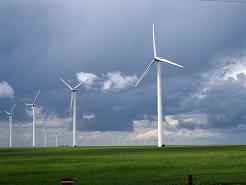 Wind energy has faced some opposition, mostly against people who are afraid their oceanfront views will be obscured by windmills seven miles offshore, but now it has a pretty tough opponent in the U.S. military.
Wind energy has faced some opposition, mostly against people who are afraid their oceanfront views will be obscured by windmills seven miles offshore, but now it has a pretty tough opponent in the U.S. military.
This article from BiofuelsWatch.com says the military is raising concerns about wind farms disrupting military radar arrays:
The primary military concern about wind farm development stems from the fact that in order to maintain adequate efficiency wind farms must operate at least 80 to 100 feed in the air, with the higher the placement the more efficient the turbines can operate due to the “cleaner” wind streams. RADAR detection, however, generally begins at roughly 50 feet, thus any wind turbines present would potentially block any RADAR signals by bouncing back signal waves with their blades and create an effective “dead zone” on the opposite side of the turbine from the RADAR emitter.
Experts say the issue could, at best, delay some projects or, at worst, cancel individual wind turbines … and even bring about a whole new set of regulations.

